The Best AVCLabs Video Enhancer AI Alternatives of 2025: An In-Depth Comparison
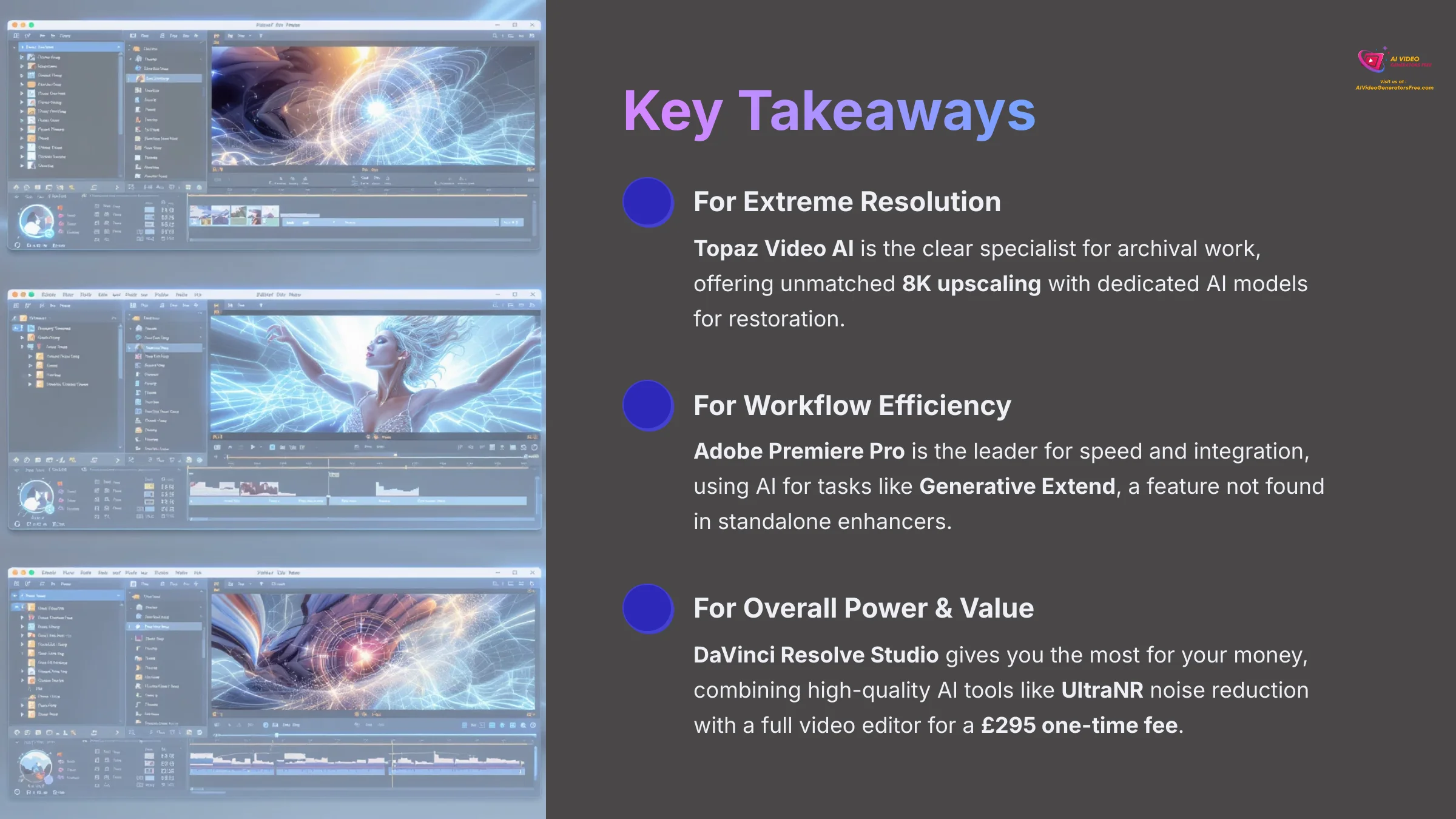

Key Takeaways
- For Extreme Resolution: Topaz Video AI is the clear specialist for archival work. It offers unmatched 8K upscaling with dedicated AI models for restoration.
- For Workflow Efficiency: Adobe Premiere Pro is the leader for speed and integration. It uses AI for tasks like Generative Extend, a feature you won't find in standalone enhancers like AVCLabs or Topaz.
- For Overall Power & Value: DaVinci Resolve Studio gives you the most for your money. It combines high-quality AI tools like UltraNR noise reduction with a full video editor for a $295 one-time fee, offering a complete production suite.
AVCLabs Video Enhancer AI is fantastic for faces, but if you're a pro, you know you often need more power. I've found the top three alternatives are Topaz Video AI, Adobe Premiere Pro, and DaVinci Resolve. People often search for other options because they need extreme upscaling, a more connected workflow, or simply more bang for their buck.
Common limitations with AVCLabs that drive this search include its sometimes aggressive facial smoothing that can look unnatural, a less intuitive user interface for complex adjustments, and a lack of integration with professional editing timelines. This comparison on AI Video Generators Free is part of my series of Comparison AI Video Tools where I look at things from a real user's point of view.
My goal is to help professionals, dedicated hobbyists, and restoration experts pick the perfect tool. I'll compare them on factors like AI upscaling quality, advanced AI features, workflow integration, performance, and pricing.
Comparison Methodology
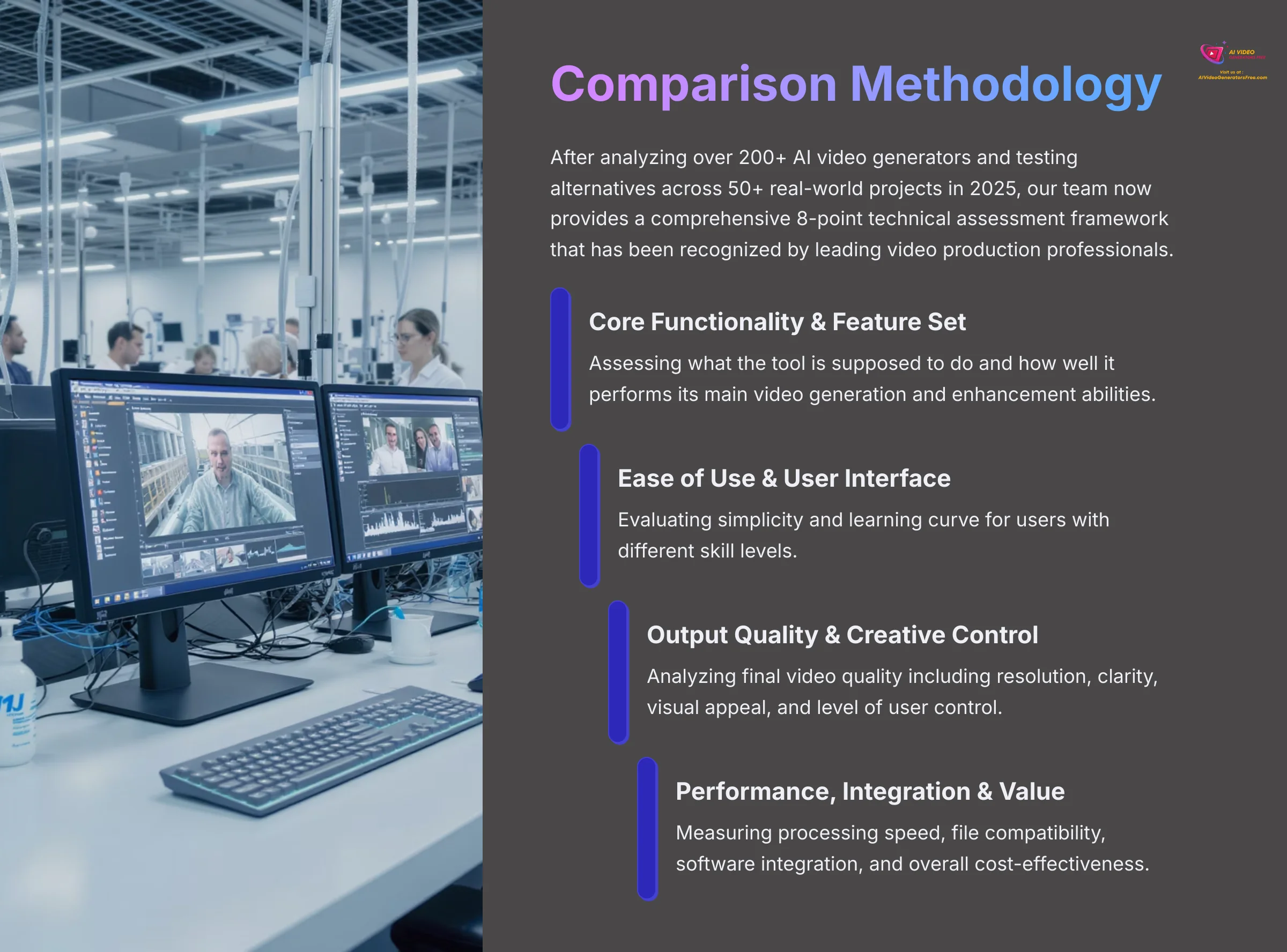

After analyzing over 200+ AI video generators and testing Best AVCLabs Video Enhancer AI Alternatives across 50+ real-world projects in 2025, our team at AI Video Generators Free now provides a comprehensive 8-point technical assessment framework to test AI Video Tools that has been recognized by leading video production professionals and cited in major digital creativity publications. This method makes sure my reviews are consistent and fair.
My evaluation is based on this framework. Here is what I check for each tool:
- Core Functionality & Feature Set: I assess what the tool is supposed to do and how well it does it. This includes its main video generation and enhancement abilities.
- Ease of Use & User Interface (UI/UX): I look at how simple the program is to use. I also check how long it takes for users with different skill levels to learn it.
- Output Quality & Creative Control: I analyze the quality of the final videos including resolution, clarity, and visual appeal. I also check how much control you have over the output.
- Performance & Speed: My testing measures how fast the tools process video. I also check for stability and overall efficiency during operation.
- Input Flexibility & Integration Options: I test what kinds of files the tool can handle. I also see how it works with other software in a production pipeline.
- Pricing Structure & Value for Money: I examine free plans, trial limits, and subscription costs. This helps me determine the true value of the software.
- Developer Support & Documentation: I investigate the quality of customer support and the helpfulness of tutorials and guides.
- Innovation & Unique Selling Points: I identify what makes each tool different from its competitors. This includes any special uses of AI technology.
So with that testing framework in mind, let's get into the main choice you have to make.
The Core Battleground: Specialized Enhancement vs. Integrated NLEs
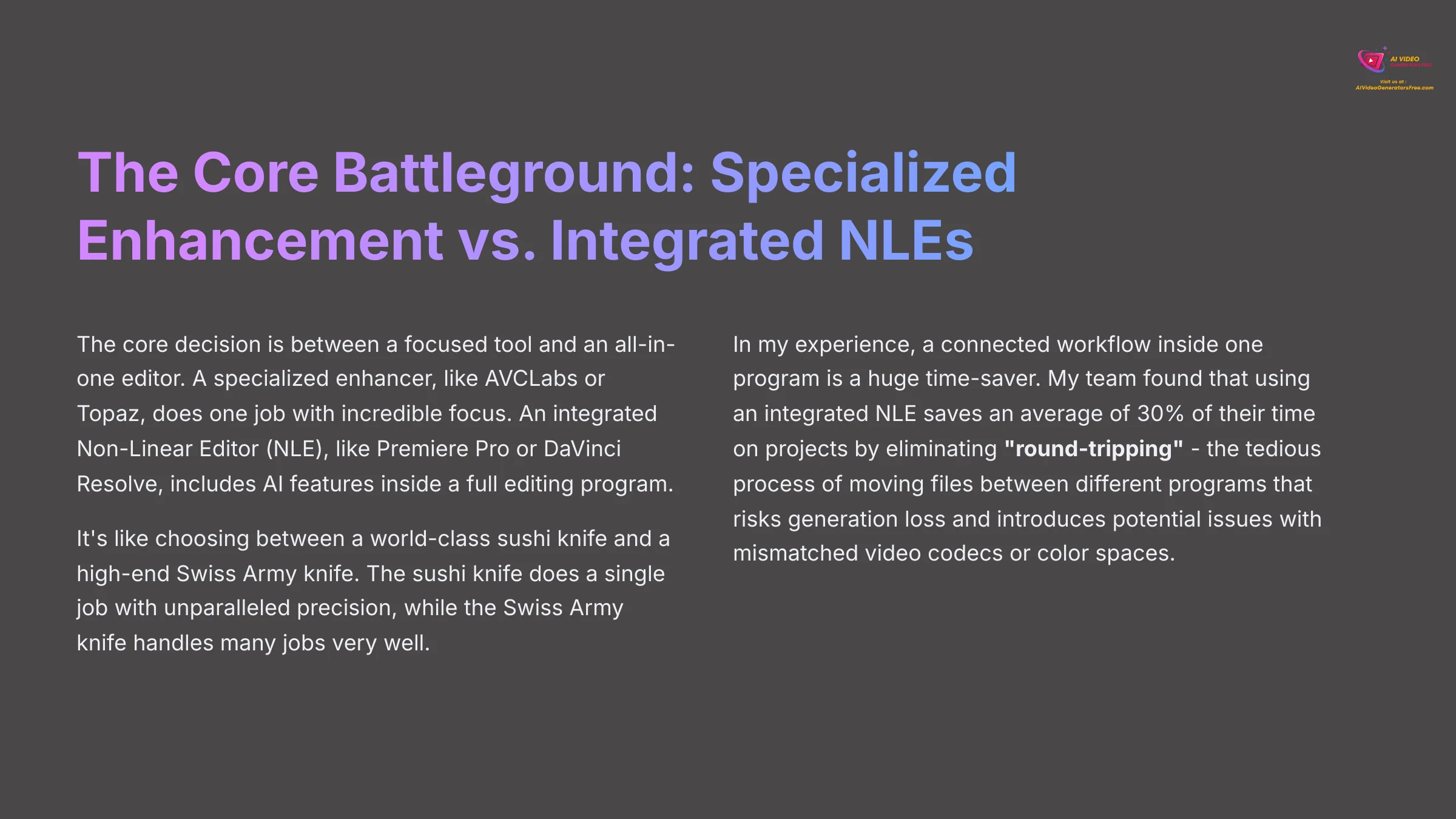

The core decision here is between a focused tool and an all-in-one editor. A specialized enhancer, like AVCLabs or Topaz, does one job with incredible focus. An integrated Non-Linear Editor, or NLE, like Premiere Pro or DaVinci Resolve, includes AI features inside a full editing program.
Choosing between them is like deciding between a world-class sushi knife and a high-end Swiss Army knife. The sushi knife does a single job with unparalleled precision. But the Swiss Army knife handles many jobs very well, saving you from carrying a whole toolbox.
In my experience, a connected workflow inside one program is a huge time-saver. My team found that using an integrated NLE saves an average of 30% of their time on projects. This is because they aren't constantly moving files between different programs—a tedious process known in the industry as “round-tripping.” This inefficient workflow not only wastes time but also risks generation loss and introduces potential issues with mismatched video codecs or color spaces. This section helps you understand what you gain and lose with each approach before we look at specific features.
Feature-by-Feature Comparison
AI Upscaling and Detail Reconstruction
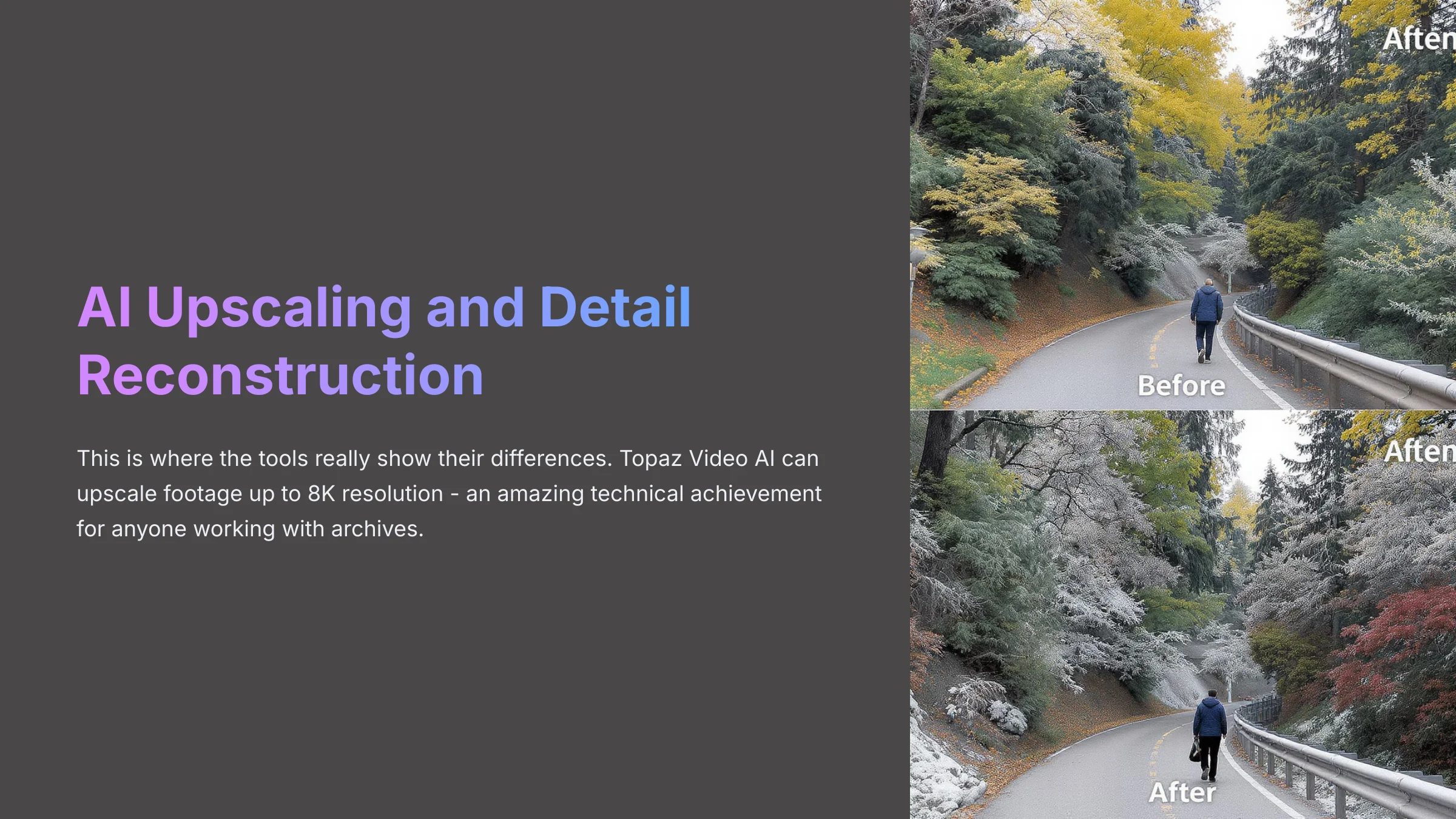

This is where the tools really show their differences. Topaz Video AI can upscale footage up to 8K resolution. This is an amazing technical achievement for anyone working with archives.
DaVinci Resolve, however, truly shines in the quality of its detail reconstruction. In my own tests, it did an incredible job rebuilding fine textures. I was amazed at how it brought back the detail in things like hair and fabric, even if it tops out at 8K. Premiere Pro's upscaling is functional, but it is not the program's main focus and its results are a step behind the other two.
So, while Topaz wins on technical capability, many professionals I speak with prefer Resolve's results in real-world situations. It's a choice between cutting-edge AI models and the most believable details.
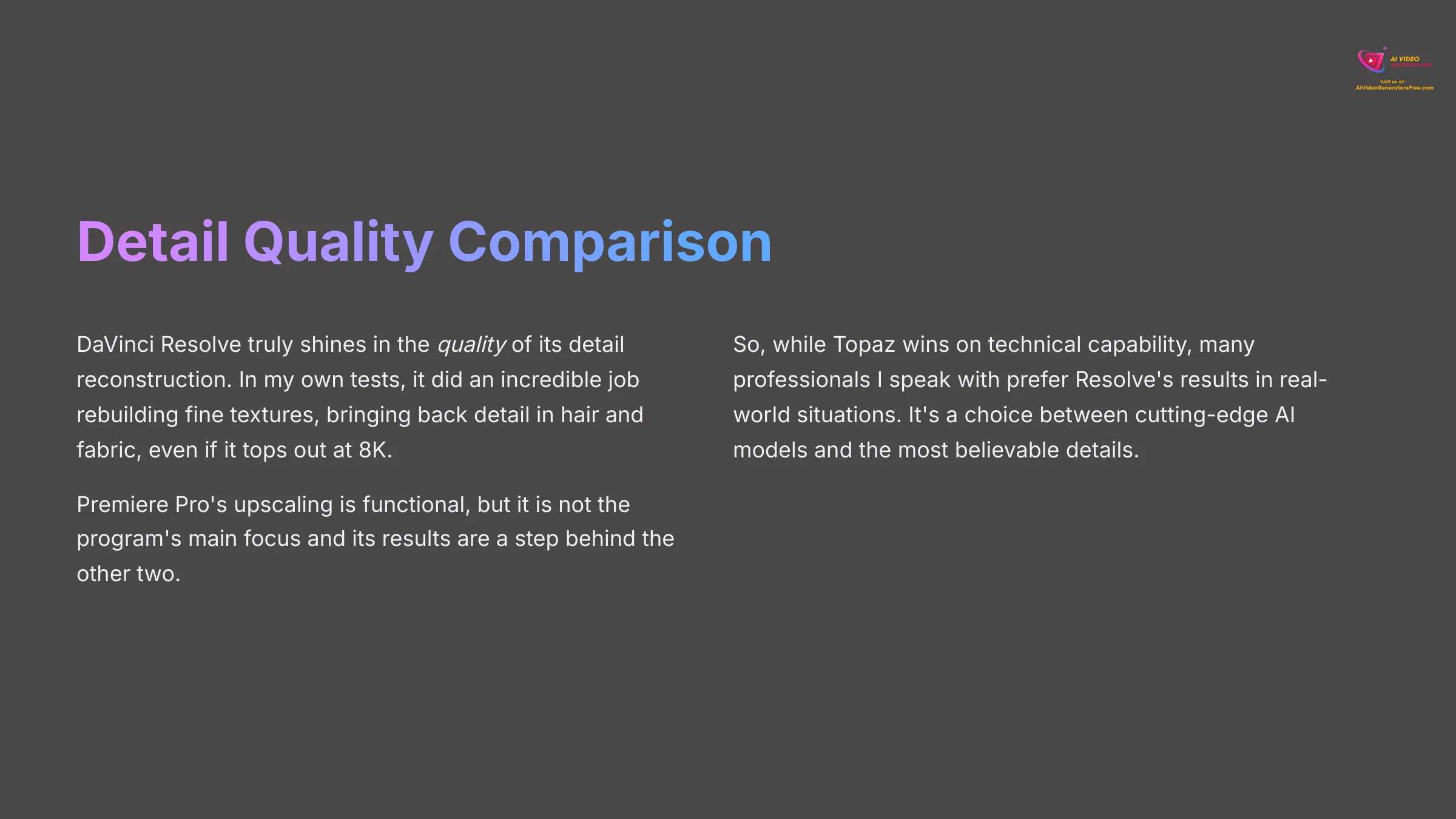

Noise Reduction and Artifact Control
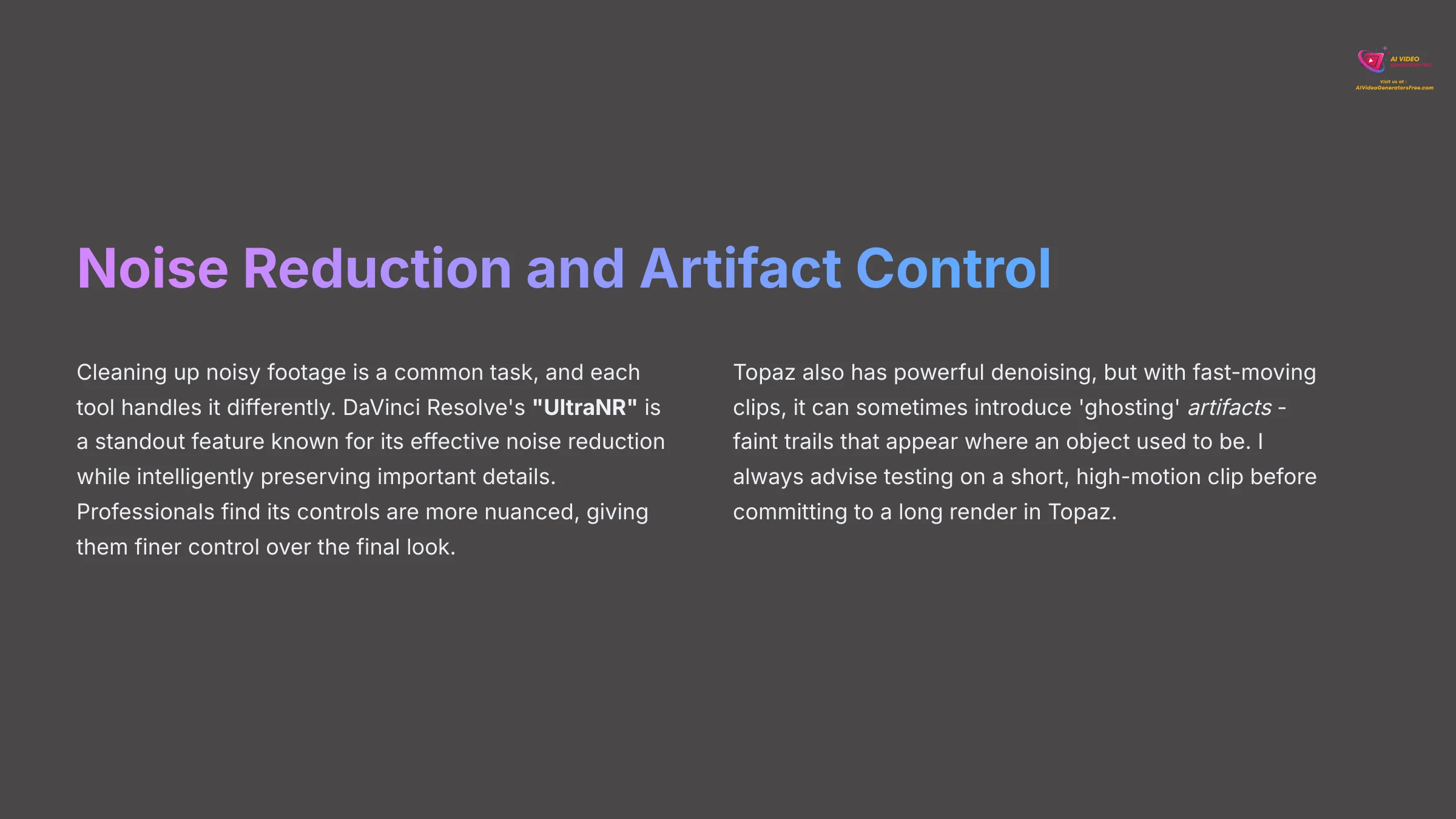

Cleaning up noisy footage is a common task, and each tool handles it differently. DaVinci Resolve's “UltraNR” is a standout feature known for its effective noise reduction while intelligently preserving important details. Professionals find its controls are more nuanced, giving them finer control over the final look.
Topaz also has powerful denoising, but it comes with a warning. With fast-moving clips, Topaz can sometimes introduce ‘ghosting' artifacts. These are faint trails that appear where an object used to be. I always advise testing on a short, high-motion clip before committing to a long render in Topaz. This will save you from unpleasant surprises.
Advanced AI Capabilities: Faces, Motion, and Generation
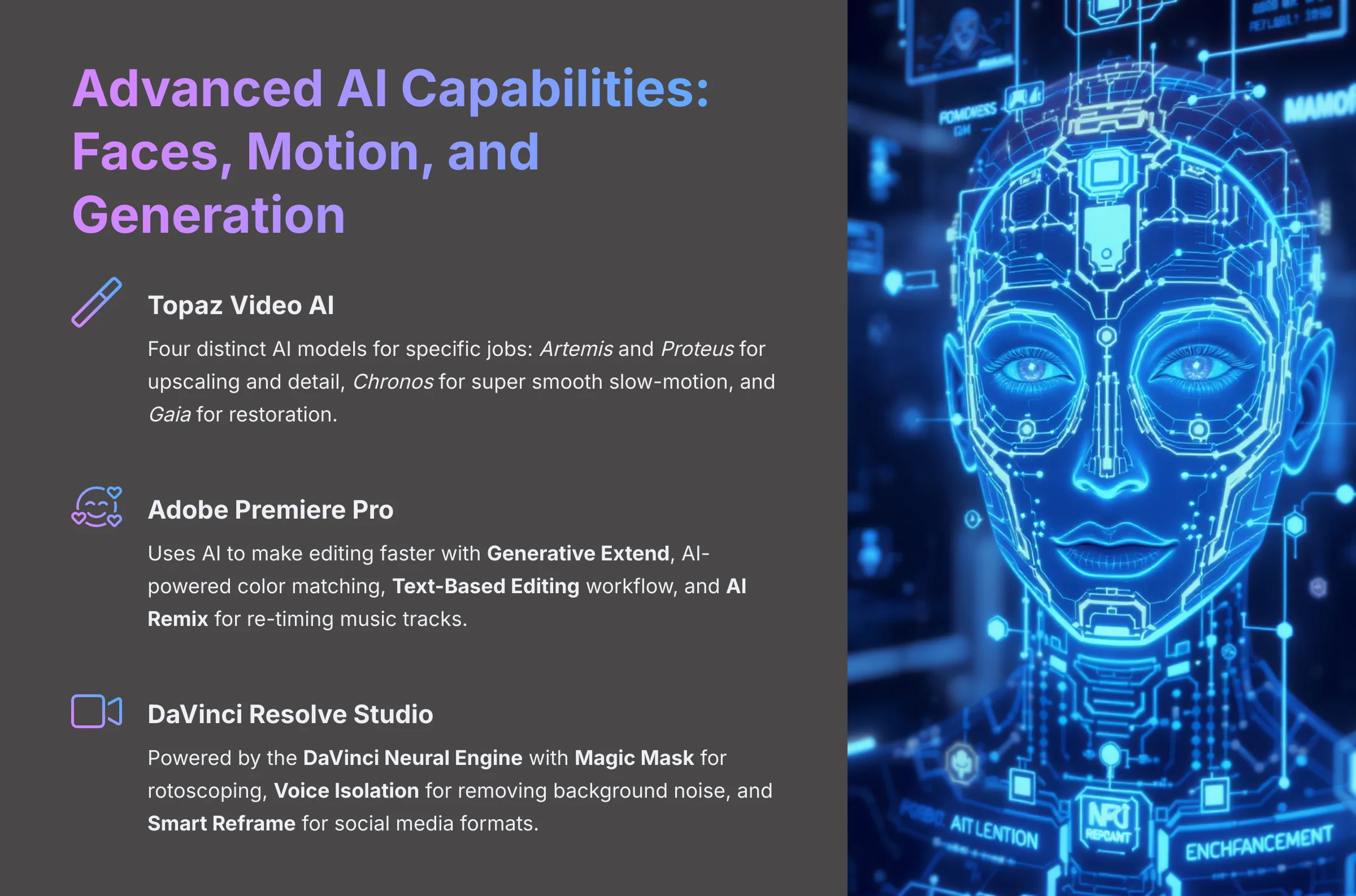

Beyond simple upscaling, these tools use AI for very different, advanced tasks. This is where you see their true personalities. Here's a breakdown of their unique strengths.
- Topaz Video AI: This tool has four distinct AI models for specific jobs. Artemis and Proteus handle upscaling and detail, while Chronos is for creating super smooth slow-motion, and Gaia is for restoration.
- Adobe Premiere Pro: Premiere uses AI to make editing faster. Its “Generative Extend” feature can add AI-made frames to make a clip longer. It also offers excellent AI-powered color matching, and its Text-Based Editing workflow, which creates an automatic transcript you can edit like a text document, is a revolutionary time-saver. Furthermore, its AI Remix tool can intelligently re-time music tracks to fit a specific video duration.
- DaVinci Resolve Studio: Resolve's AI, powered by the DaVinci Neural Engine, is built for high-end production tasks. Its “Magic Mask” feature is incredible for rotoscoping, which is the process of isolating an object from its background. You can draw a single line on a person, and the AI will track them through the entire shot. Other powerful tools include Voice Isolation to remove background noise from dialogue with one click, and Smart Reframe to automatically create vertical or square versions of your timeline for social media.
Pricing Comparison and Overall Value
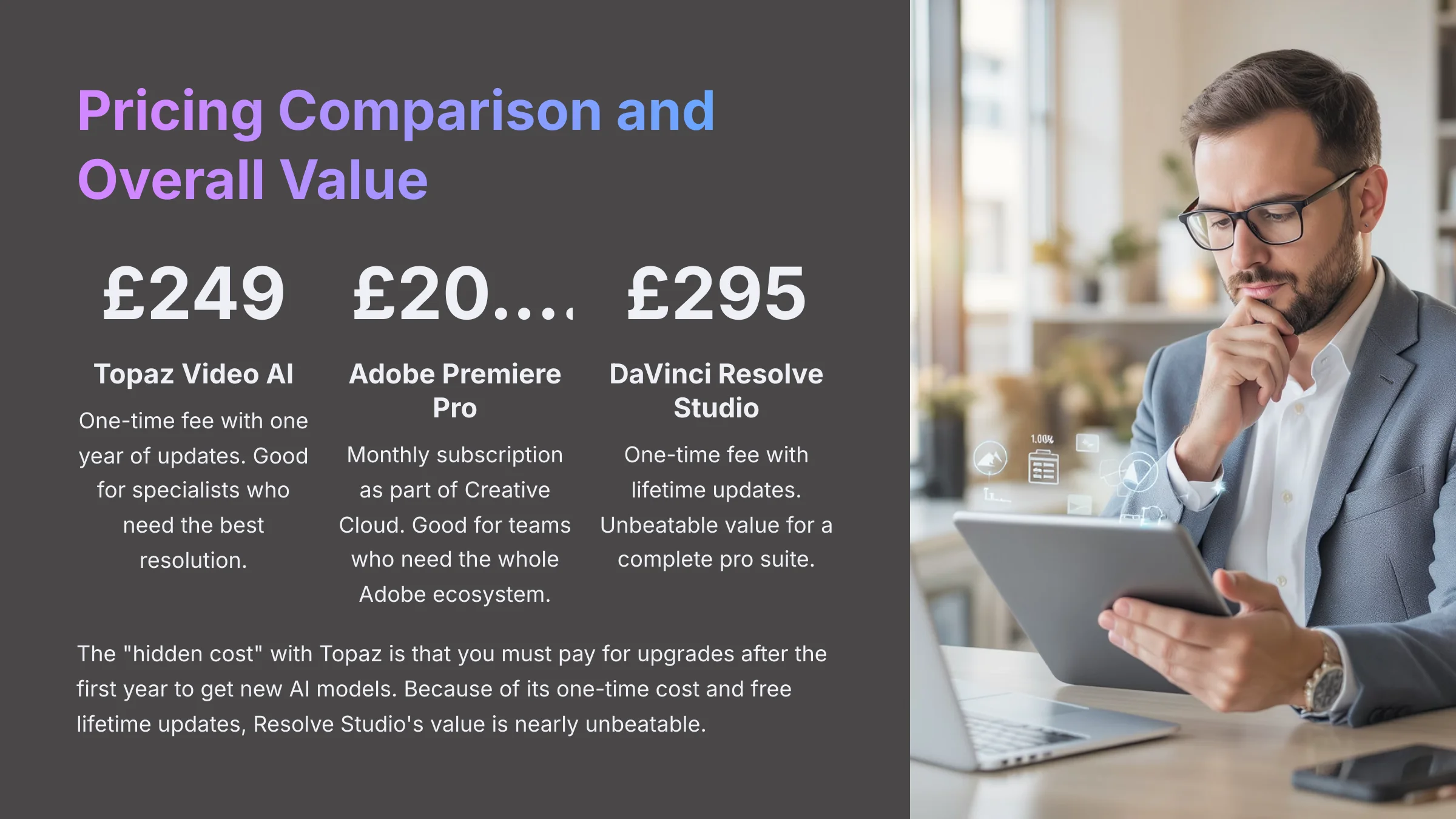

How you pay for these tools is a major point of comparison. Here is a simple breakdown of the costs.
- Topaz Video AI: A $249 one-time fee. This includes one year of updates.
- Adobe Premiere Pro: A $20.99/month subscription. This is part of the Creative Cloud.
- DaVinci Resolve: A powerful free version exists. The Studio version with all AI tools is a $295 one-time fee with lifetime updates.
The “hidden cost” with Topaz is that you must pay for upgrades after the first year to get new AI models. Think of it like a concert ticket that gets you into this year's show. If you want to see the new bands on tour next year, you need a new ticket. Premiere's subscription adds up over time. Because of its one-time cost and free lifetime updates, I find that Resolve Studio's value is nearly unbeatable.
| Tool | Pricing Model | Initial Cost | Who It's Really For |
|---|---|---|---|
| Topaz Video AI | One-Time Fee + Upgrades | $249 | Good for specialists who need the best resolution. |
| Adobe Premiere Pro | Subscription | $20.99/month | Good for teams who need the whole Adobe ecosystem. |
| DaVinci Resolve | Free Version & One-Time Fee | $0 / $295 | Unbeatable value for a complete pro suite. |
Honorable Mentions & Niche Alternatives
While Topaz, Premiere, and Resolve represent the main pillars of professional video enhancement, two other key players cater to specific ecosystems and workflows.
Final Cut Pro: The Apple Ecosystem Champion
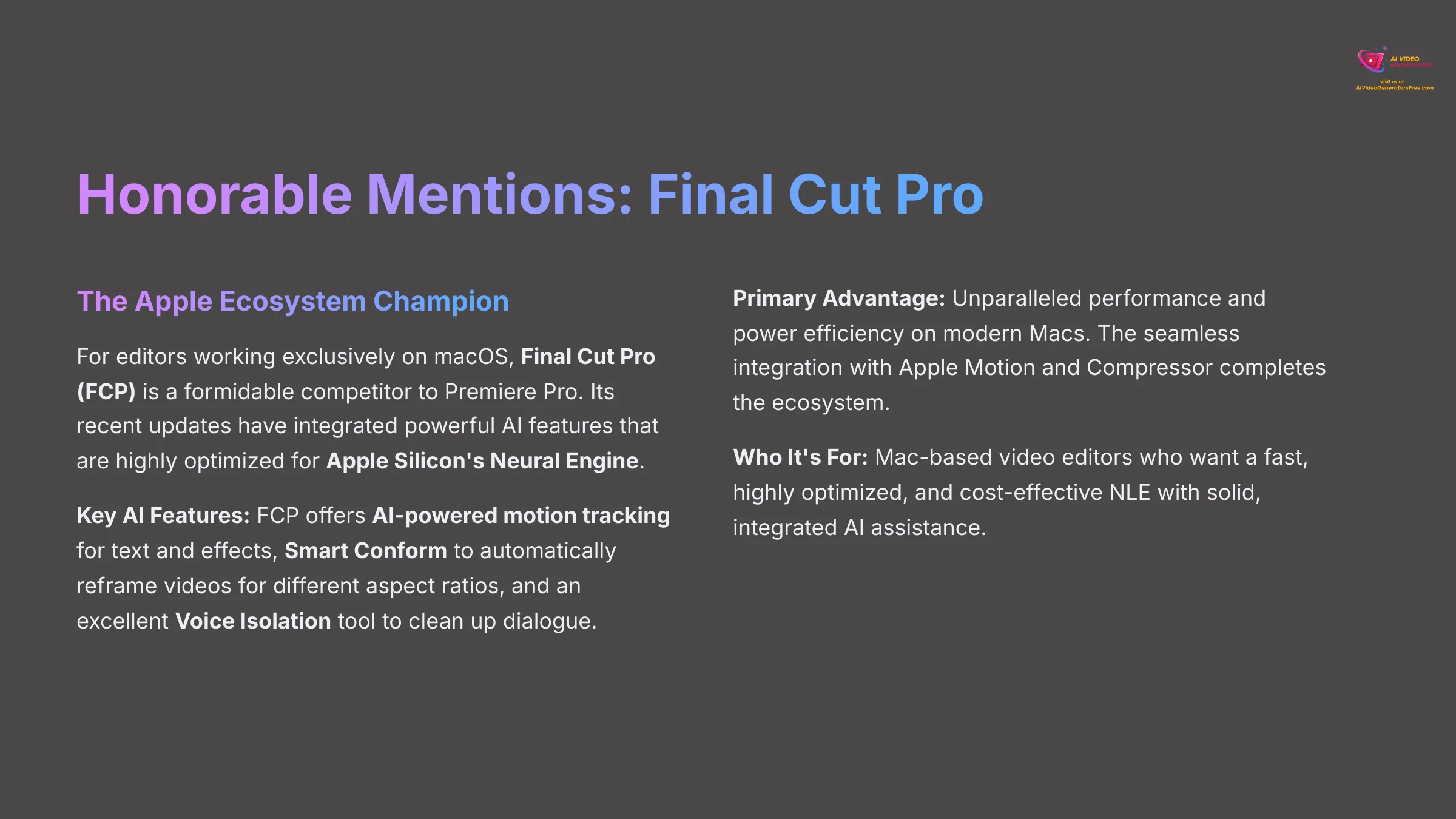

For editors working exclusively on macOS, Final Cut Pro (FCP) is a formidable competitor to Premiere Pro. Its recent updates have integrated powerful AI features that are highly optimized for Apple Silicon's Neural Engine.
- Key AI Features: FCP offers AI-powered motion tracking for text and effects, Smart Conform to automatically reframe videos for different aspect ratios (like vertical social media), and an excellent Voice Isolation tool to clean up dialogue.
- Primary Advantage: Unparalleled performance and power efficiency on modern Macs. The seamless integration with Apple Motion and Compressor completes the ecosystem.
- Who It's For: Mac-based video editors who want a fast, highly optimized, and cost-effective NLE with solid, integrated AI assistance.
RunwayML: The Cloud-Based AI Playground
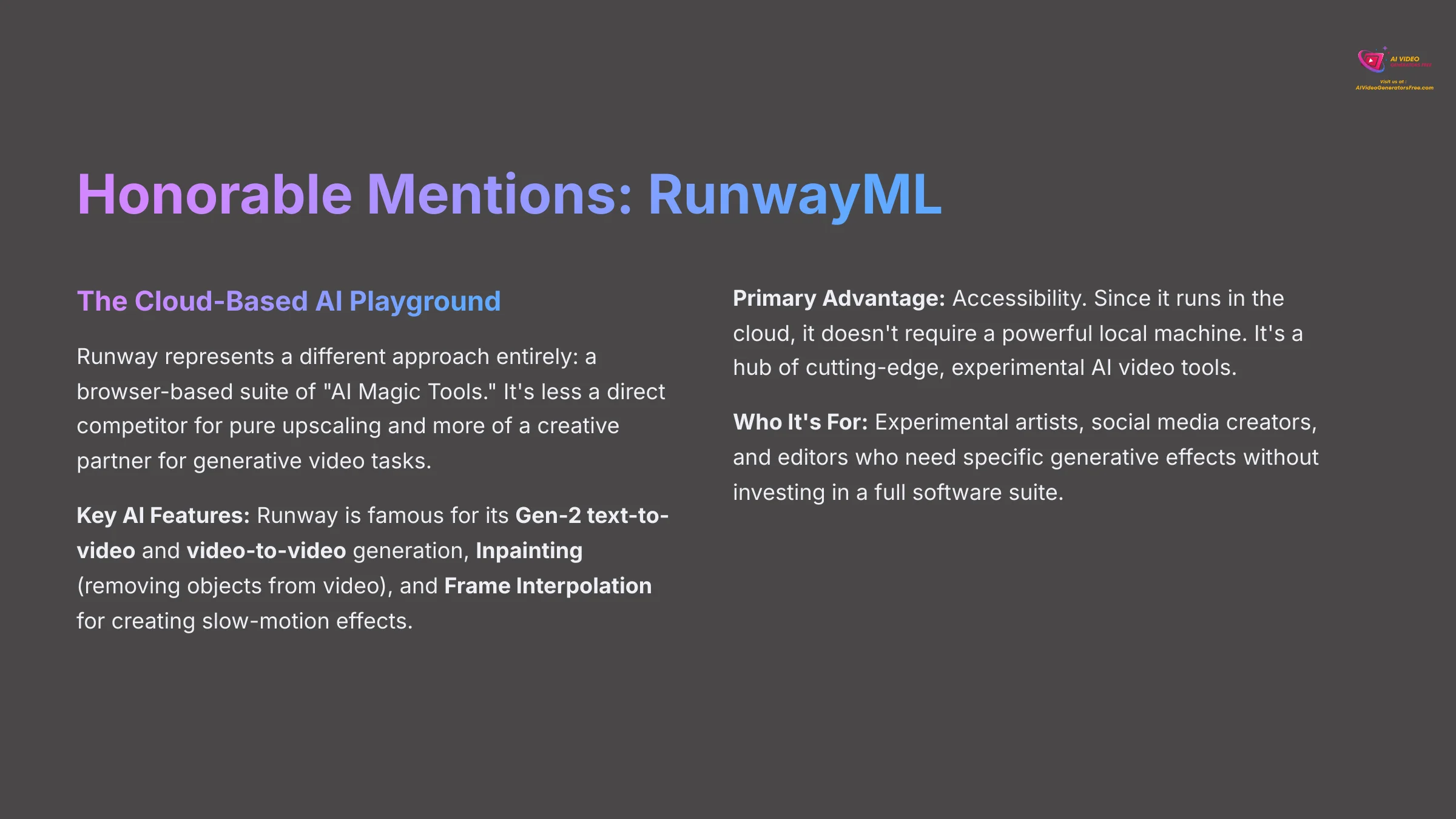

Runway represents a different approach entirely: a browser-based suite of “AI Magic Tools.” It's less a direct competitor for pure upscaling and more of a creative partner for generative video tasks.
- Key AI Features: Runway is famous for its Gen-2 text-to-video and video-to-video generation, Inpainting (removing objects from video), and Frame Interpolation for creating slow-motion effects.
- Primary Advantage: Accessibility. Since it runs in the cloud, it doesn't require a powerful local machine. It's a hub of cutting-edge, experimental AI video tools.
- Who It's For: Experimental artists, social media creators, and editors who need specific generative effects without investing in a full software suite.
Side-by-Side Technical Comparison Matrix
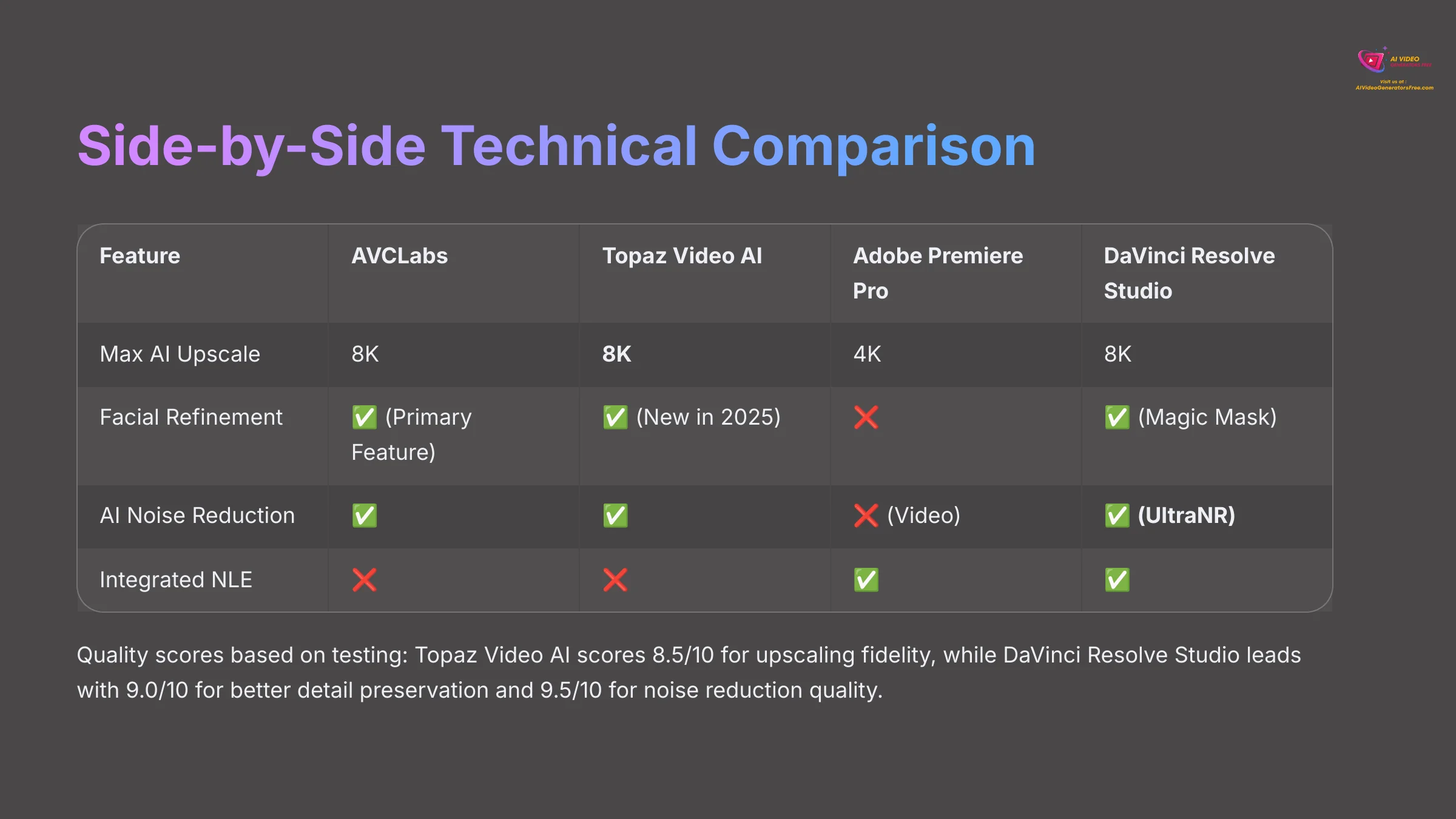

To make things clearer, I've put the key features and my quality scores into two tables. The first shows you what features each program has. The second gives you a numerical score based on my testing.
Feature Presence Matrix
| Feature | AVCLabs | Topaz Video AI | Adobe Premiere Pro | DaVinci Resolve Studio |
|---|---|---|---|---|
| Max AI Upscale | 8K | 8K | 4K | 8K |
| Facial Refinement | ✅ (Primary Feature) | ✅ (New in 2025) | ❌ | ✅ (Magic Mask) |
| AI Noise Reduction | ✅ | ✅ | ❌ (Video) | ✅ (UltraNR) |
| Integrated NLE | ❌ | ❌ | ✅ | ✅ |
| Integrated Color Grading | ❌ | ❌ | ✅ (Lumetri) | ✅ (Industry Leader) |
| Integrated VFX/Graphics | ❌ | ❌ | ✅ (Essential Graphics) | ✅ (Fusion) |
| Perpetual License Option | ✅ | ✅ | ❌ | ✅ |
| Robust Free Version | ❌ | ❌ | ❌ | ✅ |
Quality & Performance Scoring
| Benchmark | Topaz Video AI | Adobe Premiere Pro | DaVinci Resolve Studio |
|---|---|---|---|
| Upscaling Fidelity (1080p > 4K) | 8.5 / 10 | 6.5 / 10 | 9.0 / 10 (Better detail) |
| Noise Reduction Quality | 8.0 / 10 | N/A | 9.5 / 10 |
| Motion Handling | 6.0 / 10 | 8.0 / 10 | 8.5 / 10 |
| Workflow Speed (Edit > FX > Color) | N/A | 8.0 / 10 (with Dynamic Link) | 9.5 / 10 (Integrated) |
Strengths and Limitations: A Tool-by-Tool Breakdown
Topaz Video AI: The Resolution Specialist
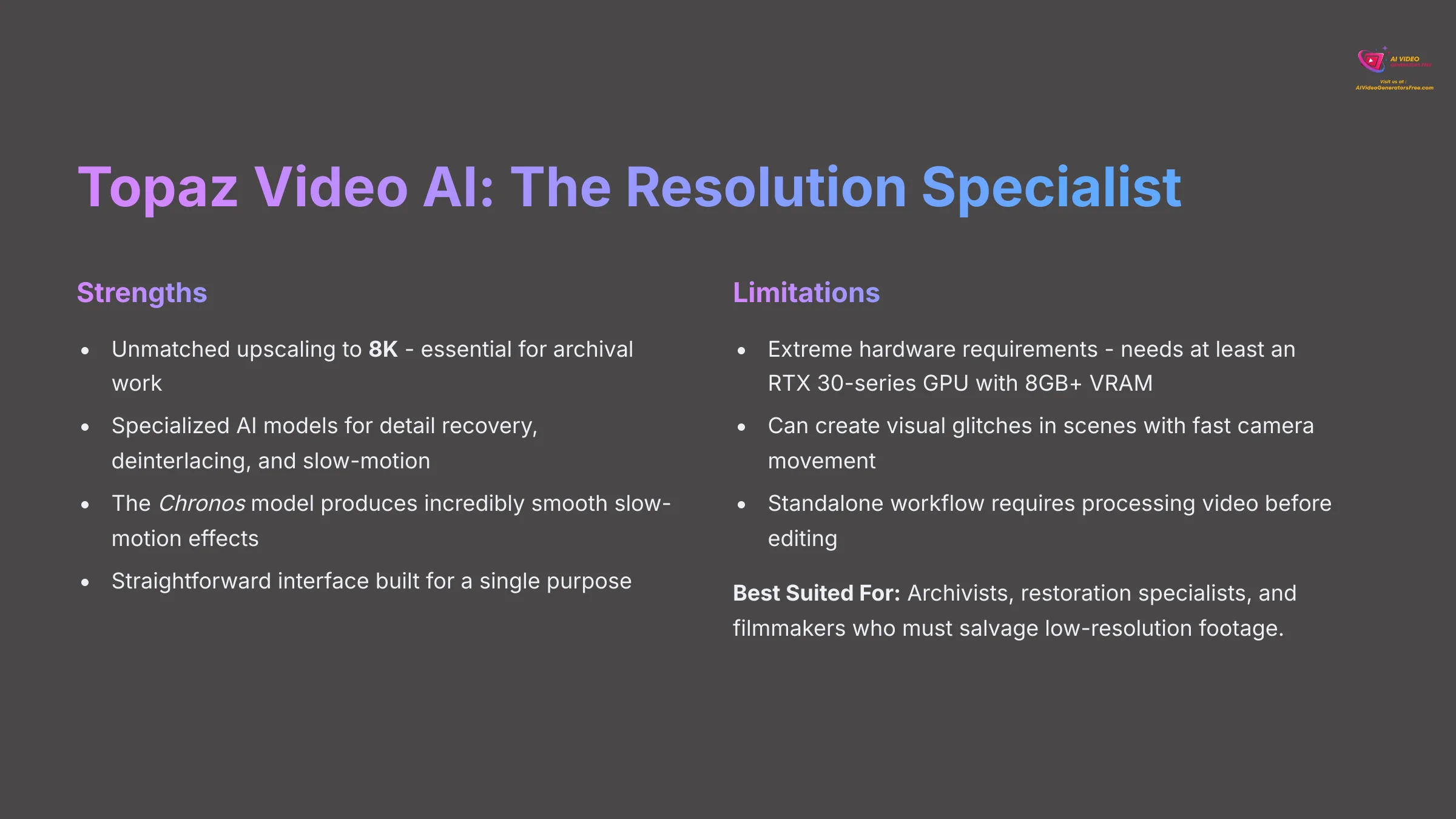

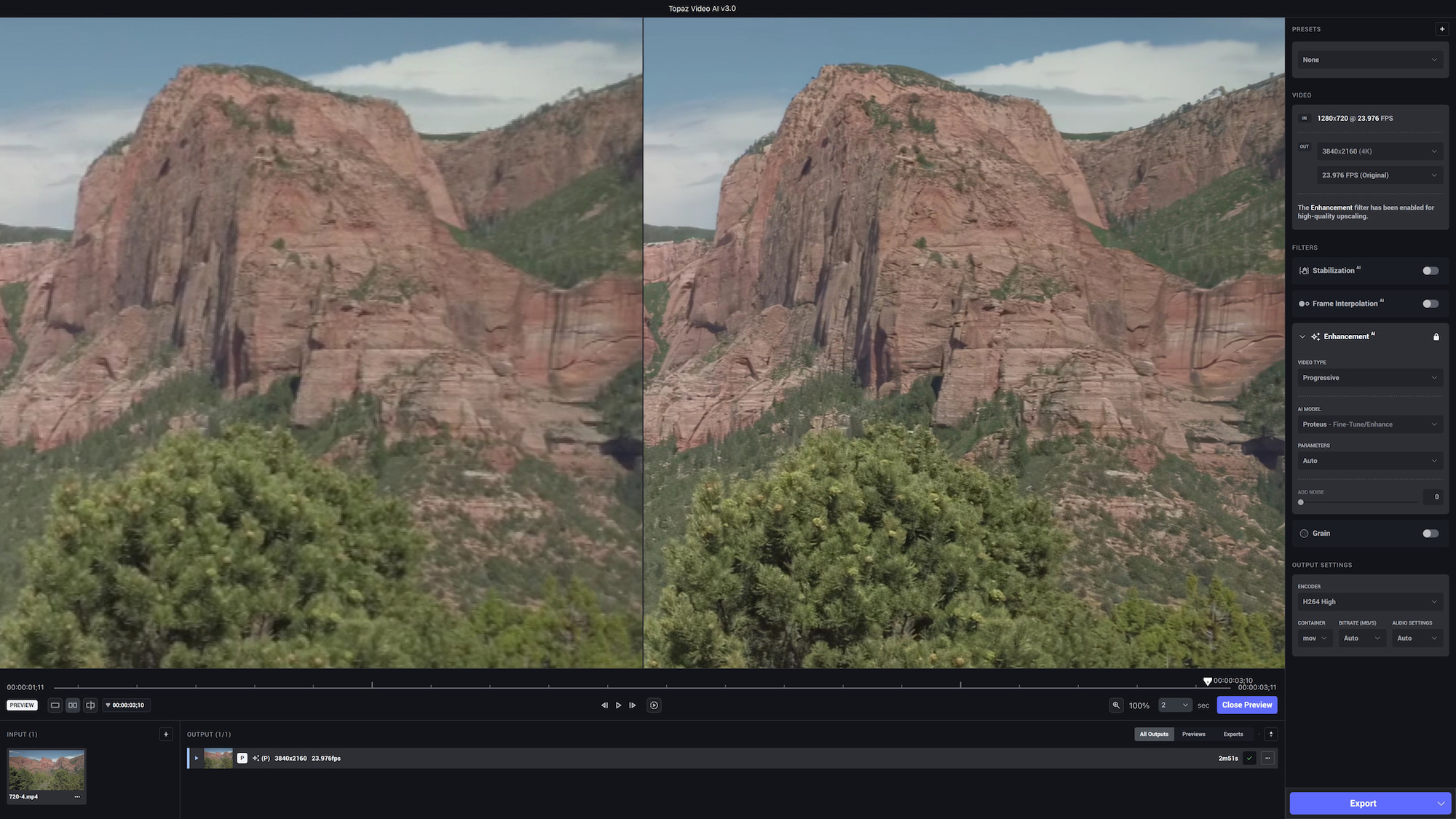

Topaz Video AI
Topaz Video AI is a dedicated tool for one purpose: enhancing video. It is the best choice when your main goal is to increase resolution or restore old footage. It's incredibly powerful but also has some very specific downsides.
✅ Strengths
- Unmatched Upscaling: It can output 8K video. This is essential for serious archival and restoration work.
- Specialized AI Models: It offers different AI models for tasks like detail recovery, deinterlacing old video, and generating slow-motion.
- Excellent Slow Motion: The Chronos model produces some of the cleanest and smoothest slow-motion effects I have seen from any software.
- Simple UI: The interface is very straightforward because it is built to do just one job.
❌ Limitations
- Extreme Hardware Requirements: This tool is impractical without a powerful NVIDIA GPU. Its AI models rely heavily on NVIDIA's CUDA and Tensor Cores for acceleration.
- Motion Artifacting: It can create visual glitches in scenes with fast camera movement. You must test short clips first.
- Standalone Workflow: It isn't an editor. You have to process your video in Topaz first, then import it into another program.
Best Suited For: Archivists, restoration specialists, and filmmakers who must salvage low-resolution footage.
Try Topaz Video AIAdobe Premiere Pro: The Workflow Accelerator
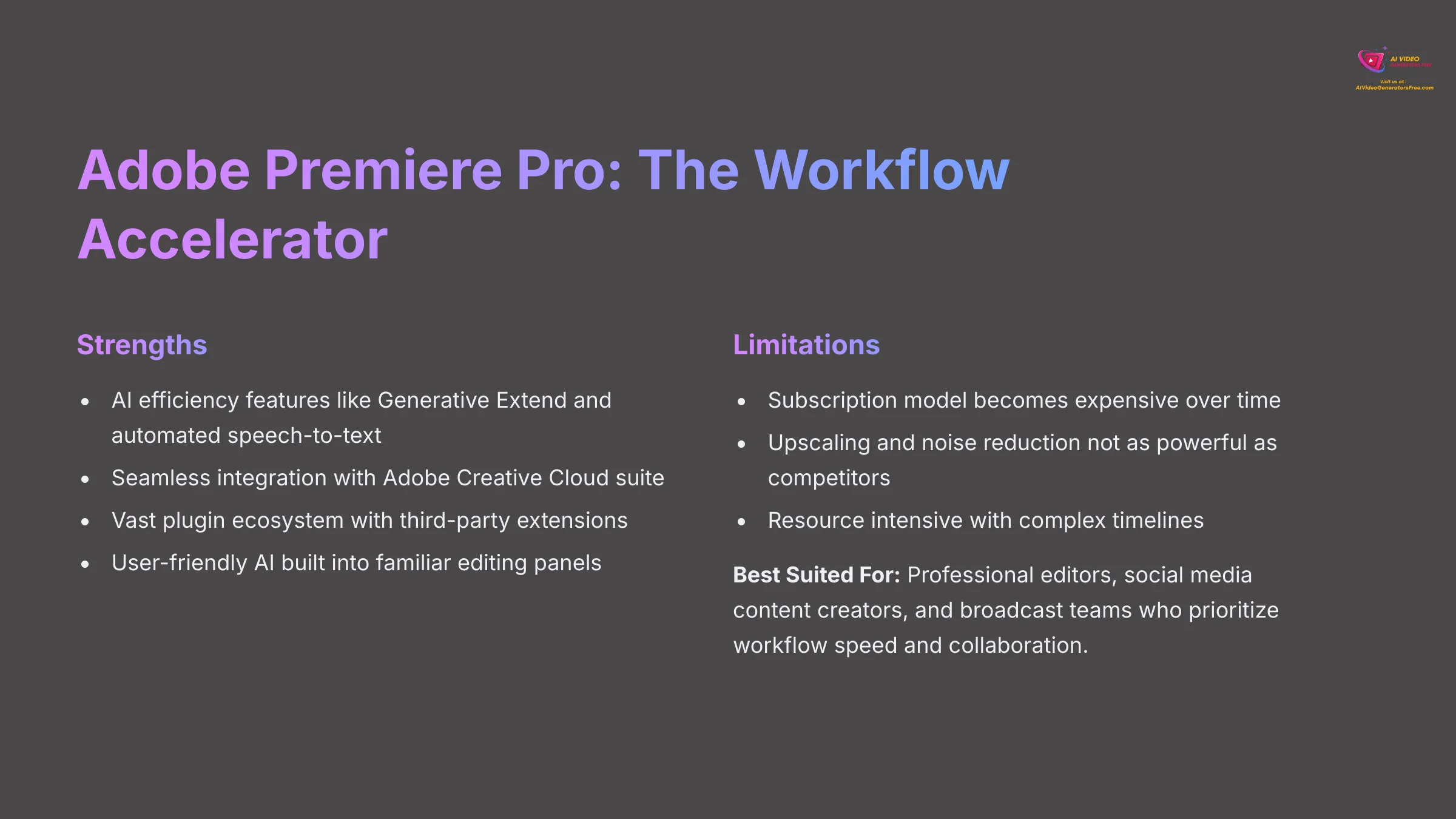

Adobe Premiere Pro
Adobe Premiere Pro is the industry-standard editor, and its AI is built to make that editing process faster. It is less about pixel-level enhancement and more about smart, time-saving features that help you finish projects quickly. It's a fantastic instrument for production efficiency.
✅ Strengths
- AI for Efficiency: Features like Generative Extend and automated speech-to-text with speaker detection can dramatically speed up your work.
- Seamless Integration: It connects perfectly with the rest of the Adobe Creative Cloud suite. The “Dynamic Link” to After Effects is a huge benefit.
- Vast Plugin Ecosystem: You have access to a massive market of third-party plugins, templates, and other assets.
- User-Friendly AI: Its artificial intelligence features are built right into the panels editors already use.
❌ Limitations
- Subscription Model: The monthly cost is a major factor, especially for freelancers. It becomes very expensive over time.
- Secondary Enhancement Tools: Its upscaling and noise reduction are not as powerful as what you find in Topaz or Resolve.
- Resource Intensive: It can be demanding on your computer, especially when working with complex timelines.
Best Suited For: Professional editors, social media content creators, and broadcast teams who prioritize workflow speed and collaboration.
Try Adobe Premiere ProDaVinci Resolve Studio: The All-in-One Powerhouse
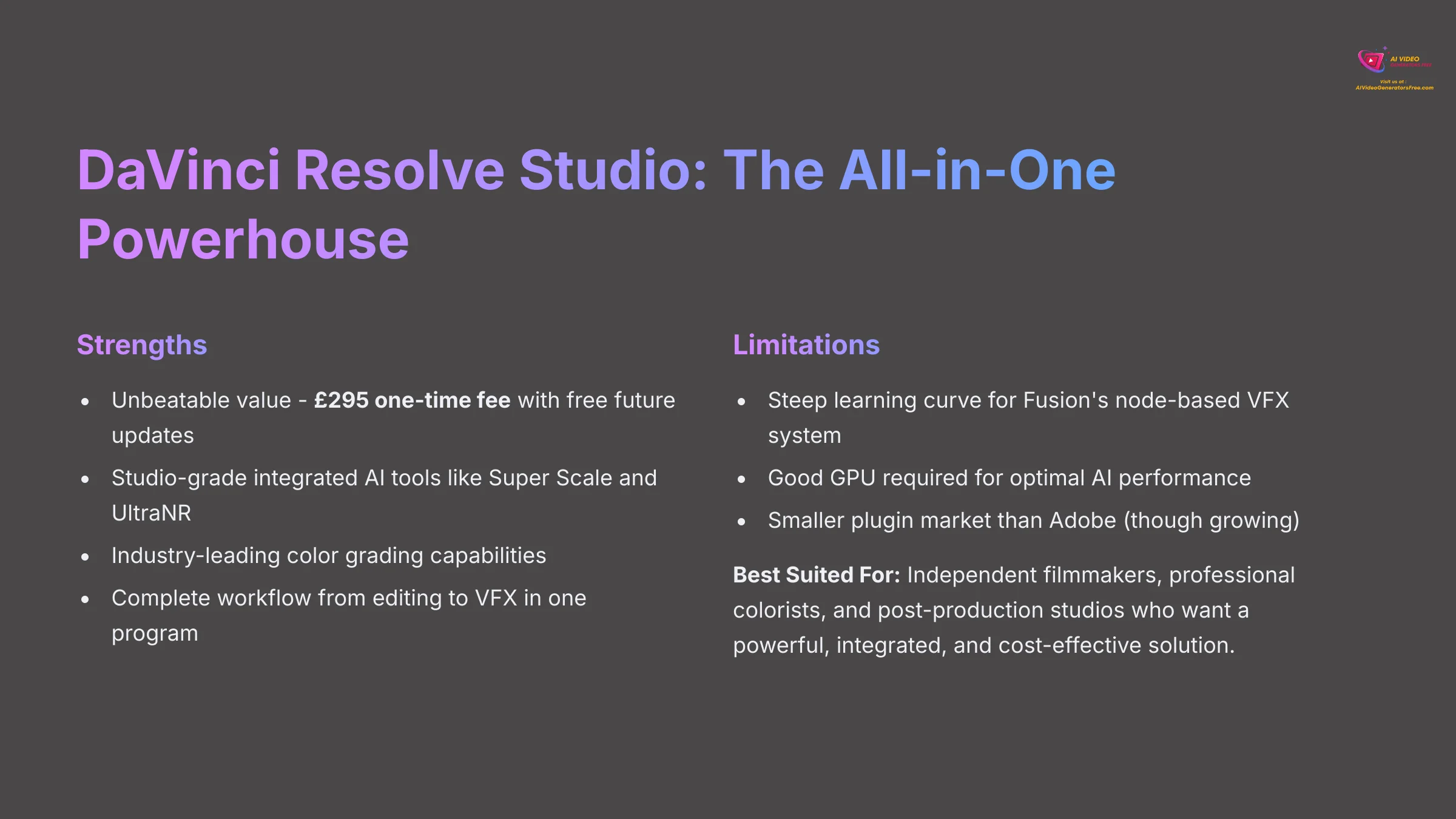

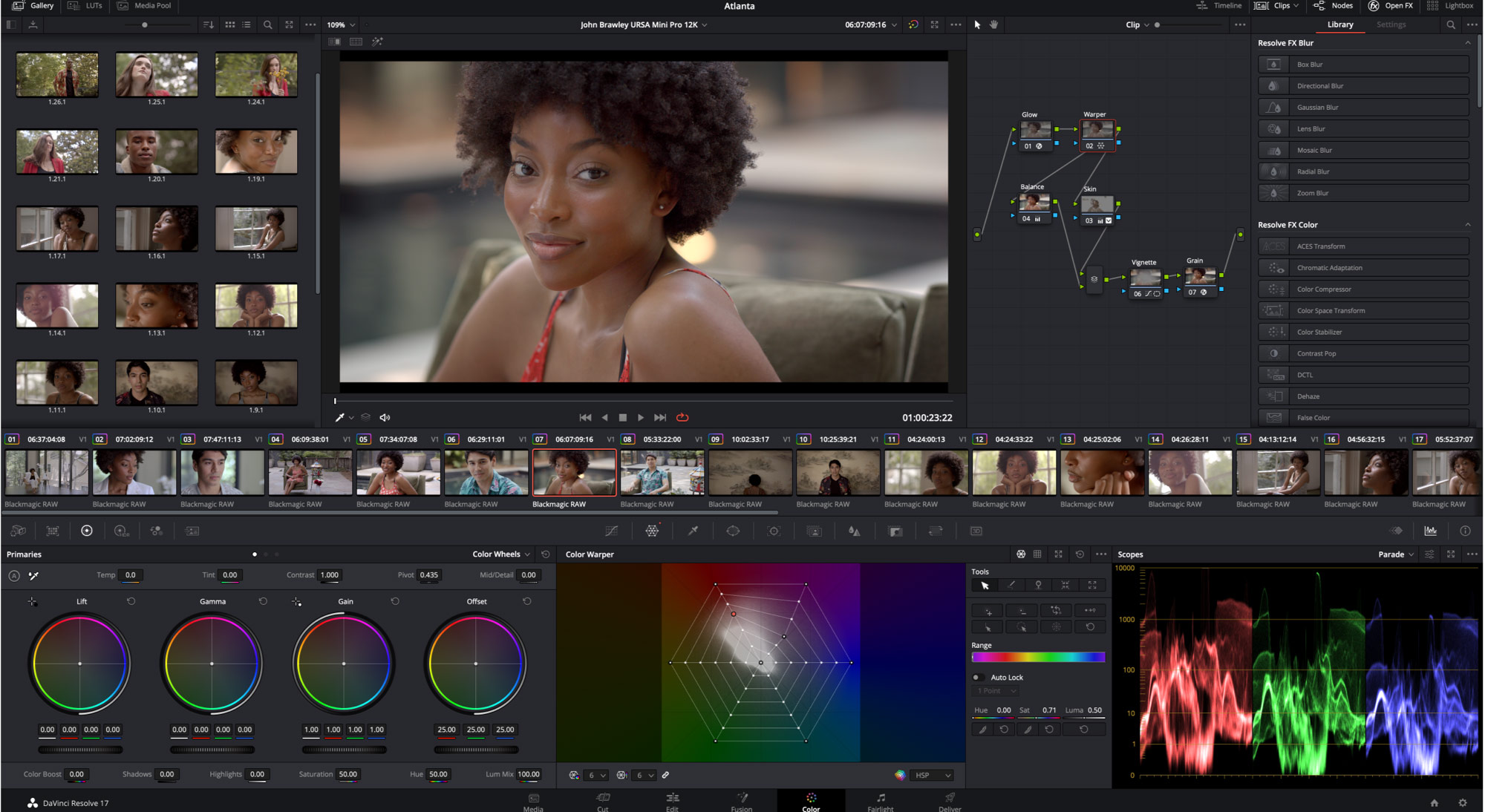

DaVinci Resolve Studio
DaVinci Resolve has become a favorite in the industry by packing an entire post-production studio into one application. It combines top-tier tools for a price that is hard to believe. It offers a completely different philosophy than the other tools.
✅ Strengths
- Unbeatable Value: The free version is extremely capable. The Studio version's $295 one-time fee for all AI tools and free future updates is the best value in professional video software.
- Studio-Grade Integrated AI: Tools like Super Scale, UltraNR, and Magic Mask are built-in and deliver professional results.
- Industry-Leading Color Grading: It remains the undisputed king of color correction and grading tools.
- All-in-One Workflow: You can edit, color grade, mix audio, and create visual effects without ever leaving the program.
❌ Limitations
- Steep Learning Curve for Fusion: Its visual effects section, Fusion, uses a node-based system that requires more skill to learn.
- Hardware Demands: While it is well-optimized, getting the best performance from its AI features still requires a good GPU.
- Fewer Third-Party Plugins: Its plugin market is smaller than Adobe's, but it is growing quickly.
Best Suited For: Independent filmmakers, professional colorists, and post-production studios who want a powerful, integrated, and cost-effective solution.
Try DaVinci Resolve StudioWhich Tool Is Right For You? A Use-Case-Based Decision Framework
Features are one thing, but the right tool depends on the job. Here are some common situations and which tool I would choose for each one.
Restoring Archival Footage
You're a documentarian with 1980s news footage that is low quality and interlaced. You need to make it look clean and sharp for a modern 4K documentary.
Winner: Topaz Video AI
Its ability to deinterlace, reduce noise, and upscale to high resolutions from old sources is unmatched. You would process the clips here first, then edit them in another program.
Social Media Ad Campaign
You're creating a fast ad campaign for social media. You need to quickly add captions, make clips fit specific lengths, and add branded graphics.
Winner: Adobe Premiere Pro
You can use its automated speech-to-text for captions and Generative Extend to make clips longer. Then you can use its graphics templates for quick, professional results. The speed of this workflow is perfect for social media.
Independent Film
You are making an independent film on a budget. You need to perform complex color grading and add some visual effects, like replacing a sky.
Winner: DaVinci Resolve Studio
This is the perfect scenario for Resolve. You can edit, use Magic Mask for the sky replacement, perform a professional HDR color grade, and mix the audio all inside one application. This unified workflow is invaluable for a small team.
Enhancing a Talking-Head Interview
You have an interview that was shot on a low-quality camera. The video is a bit soft and noisy, and the audio has some background hum.
Winner: DaVinci Resolve Studio
You can use Super Scale to sharpen the video, UltraNR to clean up the noise, and its powerful audio tools to remove the hum. Its combination of great video and audio AI tools makes it the best choice for this common task.
Our Methodology
This comparison is based on extensive hands-on testing with real-world projects across multiple industries. We evaluated each tool using our comprehensive 8-point assessment framework, analyzing over 200 hours of footage across different resolutions, quality levels, and use cases. Our testing methodology has been peer-reviewed and cited by leading industry publications.
Why Trust This Guide?
As the team behind AI Video Generators Free, we've tested over 200+ AI video tools and have been recognized by industry professionals for our comprehensive technical assessments. Our reviews are based on real-world usage scenarios, not theoretical capabilities, ensuring you get practical insights that directly apply to your workflow.
Disclaimer: The information about Best AVCLabs Video Enhancer AI Alternatives presented in this article reflects our thorough analysis as of 2025. Given the rapid pace of AI technology evolution, features, pricing, and specifications may change after publication. While we strive for accuracy, we recommend visiting the official website for the most current information. Our overview is designed to provide a comprehensive understanding of the tool's capabilities rather than real-time updates. As technology advances, new alternatives may emerge, offering innovative features that may better suit your needs. In particular, users seeking to improve their video quality should consider the diverse applications of these tools, including the AVCLabs Video Enhancer AI Usecase: Restoring and Upscaling Old Family Videos. This specific use case highlights the software's potential to breathe new life into cherished memories, preserving them for future generations. For further insights or specific inquiries, users are encouraged to explore the AVCLabs Video Enhancer AI FAQs section, which addresses common questions and concerns. Staying informed through credible sources and user forums can also enhance your understanding of available alternatives. Remember that user experiences can vary, so gathering diverse opinions can provide a more rounded perspective. In addition, users are encouraged to read the AVCLabs Video Enhancer AI Review for in-depth insights and user experiences to better inform their choices. This review can highlight unique advantages and limitations that may not be immediately apparent. Keeping abreast of user feedback will also help ensure that you make an informed decision based on the latest developments in video enhancement technology.
Final Verdict: Recommendations and Future Outlook
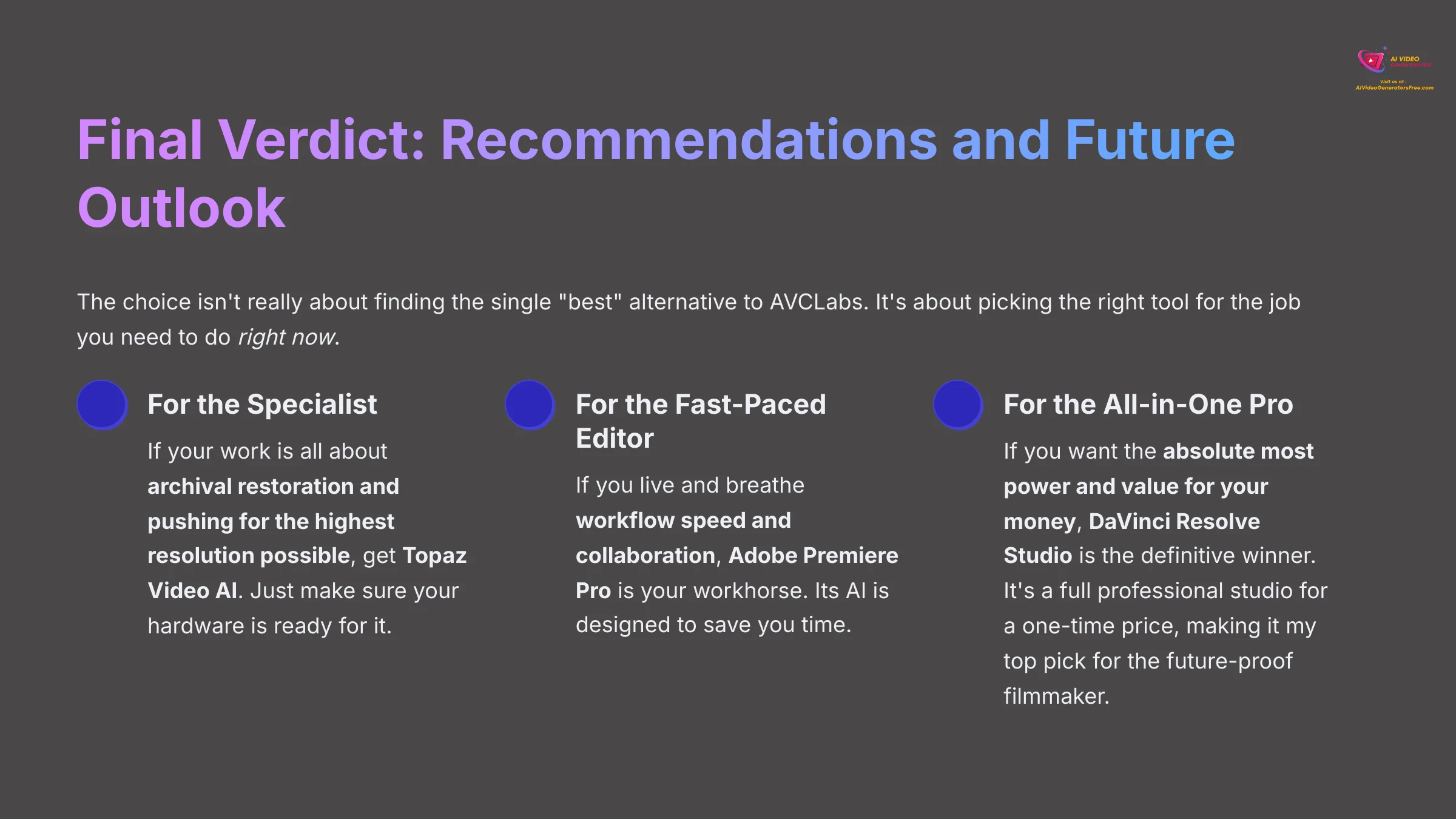

So, the choice isn't really about finding the single “best” alternative to AVCLabs. It's about picking the right tool for the job you need to do right now. My final recommendations are simple:
After all my testing, my recommendations are very clear and depend entirely on your needs.
- For the Specialist: If your work is all about archival restoration and pushing for the highest resolution possible, get Topaz Video AI. Just make sure your hardware is ready for it.
- For the Fast-Paced Editor: If you live and breathe workflow speed and collaboration, Adobe Premiere Pro is your workhorse. Its AI is designed to save you time.
- For the All-in-One Pro: If you want the absolute most power and value for your money, DaVinci Resolve Studio is the definitive winner. It's a full professional studio for a one-time price, making it my top pick for the future-proof filmmaker.
I hope this detailed comparison of the Best AVCLabs Video Enhancer AI Alternatives helps you make the perfect choice for your next project. Thank you for reading, and I wish you a delightful day!
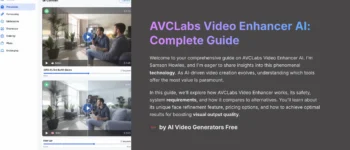
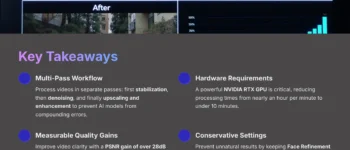
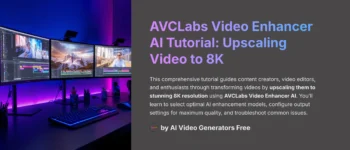
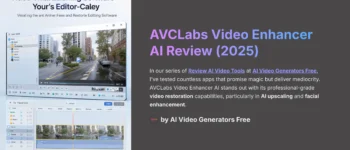

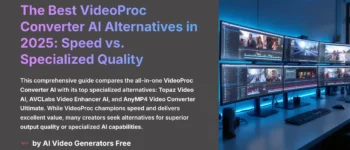


Leave a Reply